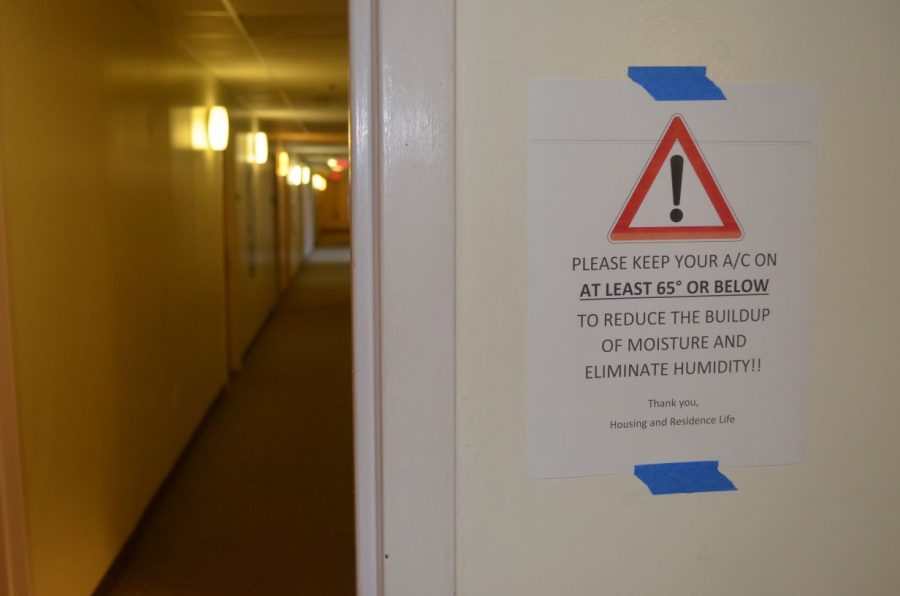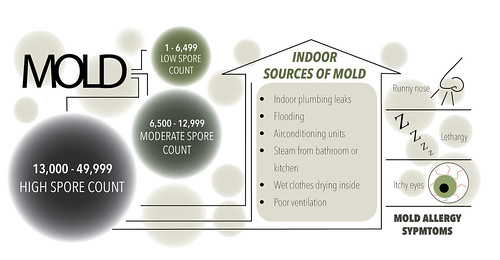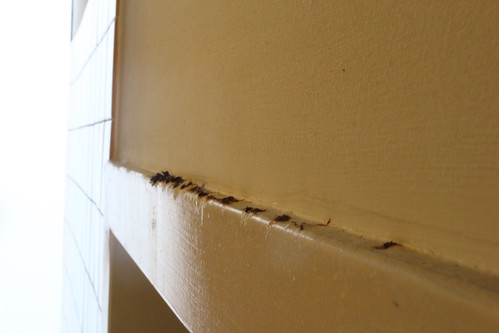Mold prompts student health, facilities concerns
Signs put up by Mayer building officials urge students to keep rooms cool to avoid moisture buildup.
October 21, 2015
Sophomore Andrea Burns made an unpleasant discovery this August when she walked into her new dorm room in Mayer Residences: patches of black mold growing in her living space.
“The mold was present on move-in day, all over the walls, doors and ceiling,” Burns said. “I wake up with really irritated and itchy eyes and I feel extremely lethargic almost every morning. The mold actually negatively affects how I feel and can focus in an educational setting.”
Black mold patches are growing in Mayer Residences and Phelps Hall, causing allergies for some of their residents. Sophomores Clare Lister, Lucy Ehrenclou and Burns have all been affected, as well as knowing friends, suitemates and roommates that have been affected. Visible mold continues to grow in many of their rooms.
“[My roommate is] allergic to mold, and toward the beginning of the semester, she would be really congested every morning, and she thinks that’s why,” Lister, a Phelps resident, said. “I’ve been pretty congested, and I started taking allergy medication … I don’t know if it’s from [the mold], but I’m sure it’s not helping.”
The most common allergy symptoms from mold exposure include congestion, sneezing, runny or itchy nose, and throat and skin irritation, according to Student Health Center Medical Director Daniel Garrett.
“Those individuals with no pre-existing conditions such as allergies or asthma may have little to no symptoms associated with mold exposure, so it’s dependent on the individual; it’s independent on their current medical condition and state,” Garrett said.
When mold growing on damp surfaces indoors such as ventilation or cooling systems dries, it releases airborne spores that can be inhaled, causing a variety of respiratory effects. Released spores can survive harsh environmental conditions that normal mold, which thrives in humid conditions, cannot, such as dry air.
Infographic by Tasha Sirotak
Ehrenclou found mold behind her walls that has persisted and continued to cause allergy symptoms.
“I’m pretty allergic to it,” Ehrenclou said. “I’ve had pretty bad allergies — stuffy nose, scratchy throat, itchy eyes and a cough — because of it, but I manage with an air purifier and Claritin.”
Ehrenclou knows other residents in Mayer inconvenienced by the growth of mold.
“The two rooms below mine and the suite attached to mine were apparently covered in mold — my good friend was supposed to move in there and had to relocate to Warren when she arrived on campus to maintenance men putting up new drywall in her room,” Ehrenclou said.
Lister and her roommate noticed a patch toward the bathroom door. Their resident adviser told them the issue constituted an Emergency Service Wave call, but her roommate had already contacted Service Wave. They came within the next couple of days to fix the problem.
“The primary way a student would report something is through Service Wave,” Housing and Residence Life’s Director of Facilities Jon Tingley said. “Now let’s say it’s an emergency: someone might call our front desk about it, or they might do a Service Wave … the information will get back to me and I’ll talk to our Facilities Liaison to get it handled quickly.”
Ehrenclou said that due to mold and a leak in her ceiling from the air conditioning unit in the room above, she called Service Wave four times in roughly two weeks.
Service Wave can bleach, spray or scrape off the mold. Mayer building officials, through signs in the hallways, suggest that residents keep their rooms at a temperature of 65 degrees Fahrenheit or below. This is in accordance with Centers for Disease Control and Prevention guidelines, which recommend that a room’s humidity levels be kept at 50 percent or lower to limit moisture and prevent mold growth.
An email sent to Mayer residents by Resident Director Tion Taylor attributes the mold to the “New Orleans climate.”
“The fact is that there’s mold all around us … it’s just part of living here,” Tingley said. “What we don’t want is mold in a residence space that’s going to affect their ability to live there … The reason they put those [signs] up is because when the air conditioning system is running well, it’s supposed to take the moisture out of the space.”
New Orleans has a history of mold growth, especially after the devastation of Hurricane Katrina left most of the city submerged in water. Research done by the Natural Resources Defense Council immediately after Hurricane Katrina showed a maximum outdoor spore concentration of 101,000. The National Allergy Bureau counts spore numbers above 50,000 as “very high,” its highest level. Today, environmental mold levels have returned to normal.
Indoor mold growth, however, is still an issue in such a humid and local climate.
“It actually smells in the hallways of mold and our RA has acknowledged the issue, too,” Burns said.
Alyssa Bialek | Associate Photography Editor
Though residents may be acutely aware of the mold’s presence, officials at the Student Health Center have not necessarily seen an increase in patients suffering from mold exposure symptoms.
“I have heard reports that there were concerns of mold within the buildings here on campus … predominantly [from] students,” Garrett said.
Garrett noted that while the Student Health Center has treated students for symptoms relating to mold-reactive symptoms, he would not say there has been a recent or significant influx of mold-related concerns this semester.
Reliable sampling for mold can be expensive, and the CDC does not recommend it. HRL does not sample for mold in any of the dorms regularly and handles mold on a case-to-case basis, allowing the Office of Environmental Health and Safety to test for mold if the covered area is larger than 10 square feet.
“The goal of testing would be to find the impact of the mold being there, and if it’s smaller than 10 square feet, the impact is negligible,” Tingley said. “For us, it’s better to get it taken care of than to [wait] to get the test results back.”
Tingley said that all types of mold have the same effect on humans, adding a degree of potential irrelevance to the sampling and testing process. He also said that living quarters are thoroughly inspected by facilities staff over the summer, beginning with furniture, wall and floor inspections for items in need of repair, general health and safety checks, and cleaning by custodial staff.
Neither federal law, such as through the Environmental Protection Agency or the Occupational Safety and Health Administration, nor Louisiana state law requires that Tulane test for mold in the facilities before permitting students to live there.
Public buildings under the Sanitary Code must also provide proper heating, lighting and ventilation — ventilation being the key link to the mold problem — but Tulane is not explicitly a public building in the context of this section of the code.
There remains some disparity between how students believe HRL has responded to their mold complaints and HRL’s perceived clarity of their own procedures.
“The obvious neglect was disappointing as I had to return this fall to disgusting living conditions,” Burns said. “I think Tulane is trying their best to cover up their lack of involvement in the mold … the conditions of the rooms should be placed with a higher priority.”
Lucy Ehrenclou previously contributed photographs to The Hullabaloo.












Leave a Comment